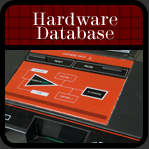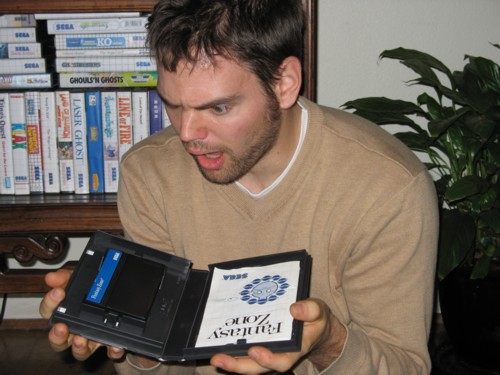 |
||
|---|---|---|
| What the hell? Why is it blue? |
The sadness, the glory, the whatever-you-want to say about the NTSC market for the Master System. Though this is beyond the scope of what I currently have to say, it's clear to most collectors out there that the console simply didn't do very well in the states. We plan on eventually adding some thorough history sections to the site detailing release information, variations and so forth from different countries and markets, but for now I have something small for all of you who may be interesting in one of the least understood areas of SMS collecting. What is it? I'm talking about the blues my friends.
Some of you, though I doubt it, may not even be aware of their existence or may only know of two, but there are plenty and they tend to cause a terrible pain to anyone who tries to find them all. They are by far the most difficult to find in a few cases and as of yet no one has known anything about why they were even produced in the United States. That's our goal for this article, I'm going to lay it all out for you with the help of an insider who worked for Sega of America (John Sauer). I'd also like to thank forum member Tonto for his help in finding these babies, as well as the eBay legend nebrazca78. At any rate, get ready folks, here it is, the history, the tears, the truth. Let's get it done with once and for all for everyone out there who wants it and needs it; I'm about to present to you the history of the rerelease titles for the Sega Master System on the NTSC market.
Back in the mid-80s, the United States was brought out of the supposed video game crash by the unstoppable Nintendo NES. So powerful was Nintendo's stranglehold that they had over 90% of the market a few years after their console was released. Everyone, of course, knows about their notorious "third-party" developer policy, and this is likely the major factor that dampened the SMS in America. So much did Nintendo damage Sega that they decided to lift the majority of their marketing for the system from the United States, giving it to Tonka in 1988. Unfortunately, in spite of the fact that the company helped Sega stay afloat, it was soon realized that the likelihood of overcoming the literal monopoly held by Nintendo was slight, at best. With Tonka's help (aside from what you may read on Wikipedia and other 'reputable' sources), the system managed to keep a stable, albeit low, position on the market.
By 1989, with the success of the Genesis/Megadrive overshadowing the NES, Sega then took control away from Tonka. This was due to two reasons. One, Tonka was merely a business partner and were never mentioned "in the same breath as Sega," to quote John, because Sega was the "household name." Tonka merely took over the marketing and did nothing with the system itself. And two, little known to others, Tonka merged with Kenner and Parker Brothers and moved their operations to the east coast. Until that time, Sega's main area of operation in the US was previously in San Fransisco, California, so they decided to head home to keep the Master System alive while the Genesis/Megadrive was entering the market. By 1990 they were beginning to gain third-party support as their new system started to grow in popularity, and the focus shifted. It is during this time that problems began for us collectors that we need to understand.
When Sega grabbed back marketing control of the Master System from Tonka, it wasn't to attempt to revive the console in America, they simply wanted to have control of it while they were busy getting the public ready for the Genesis/Megadrive. The Master System was thus put behind its 16-Bit successor in terms of importance, but before phasing out the system, since it still held a strong fanbase worldwide, they decided to try to give it a little jumpstart in the United States while they were simultaneously working with their new 16-Bit console. Their "brand strategy" (again quoting John) was to slowly phase out the SMS while building support for the Genesis/Megadrive. Right before Sega gained back control, Tonka had an idea that is eventually where our story leads us.
According to John, due to uncertainty on the part of buyers and store owners, people were sometimes confused as to what type of game was what when looking at the box. Though most of us clearly realize Fantasy Zone is a shooter, it was difficult to tell exactly what the game was without playing it. I mean look at it, you've got this sun-looking thing with a little thing flying towards it. What is it? There were a number of games like this. Tonka was thinking, based on success with games like Phantasy Star, that by adding a sunburst in the upper left for the box inserts and adding text to clearly mark their genre like Nintendo did in the early days of the NES, they would be able to draw more attention to the name "Sega" while the Genesis/Megadrive was only just beginning. In fact, if you look at some earlier games, they were released in just this fashion. In addition, this scheme would enable them to better gauge market potential for game titles and keep track of gamers' interests. In fact, as verified for once, they did the same thing with early Genesis/Megadrive packaging. So what was this scheme? It's simple, they decided to repackage.
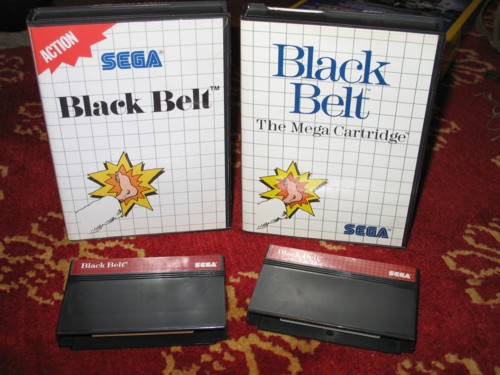 | ||
|
The Black Belt duo of doom.
|
As you can see from this single example, a few things were changed that are immediately recognizable on all but three of the rereleases, simply by looking at the front of the box. On the right is the original release of Black Belt, and on the left is the rerelease. As you can see, Tonka added a sunburst with "Action" at the upper left, shifted the location of the Sega logo to make it more visible, removed any mention of "Mega Cartridge," altered the artwork slightly, and then made the lettering a bold black instead of the original blue style, again so the game stood out on the shelves. The removal of "Mega Cartridge" was intended to keep idiotic, frightened buyers as little confused as possible, deleting all references to anything technical so no one got hurt; leaving only the game's title and genre. But this isn't all they changed, let's use the same example so you can see further.
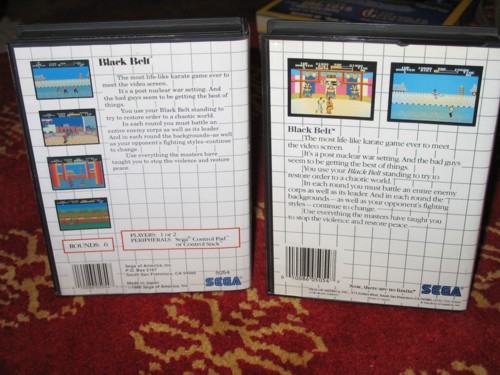 | ||
|
Behind the duo of doom.
|
As you can see, the back of the box was also altered. In addition to the screenshots being placed on the left instead of at the top, there are two additional images. The game title is again in bold, though the box text remains the same. At the bottom, where once stood a line of information, is now only two blocks, and you'll also notice the early marketing phrase "Now There Are No Limits" absent. They also added the number of players, peripheral type to use while playing, and the number of rounds so buyers could easily recognize what they were purchasing. So now you know how to spot all except two of these puppies easily in any auction lot or single auction, but let's show you one additional feature in case the seller happens to be stupid enough, and annoying enough, to only display the spines of the games.
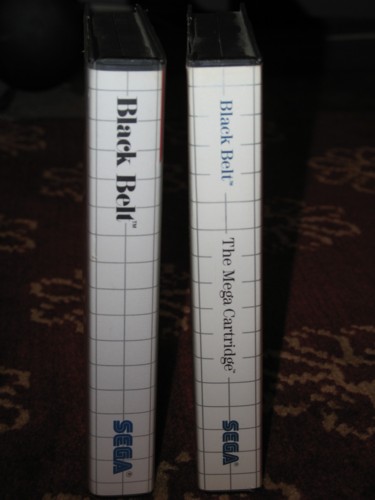 | ||
|
BOOM baby!
|
The other feature tossed into the mix is, as you can see, an additional black and bold logo on the side of the box, minus any mention of "Mega Cartridge." As stated above, but let me do it again, this was to make it easier for buyers to understand what they were getting without possibly confusing them with mention of hardware. Who really cared or knew what 'mega' referred to anyway? Generally, the main reason, as you can see, was so it stood out. But in the first picture above you may also notice one problem. You've certainly heard about the blue rereleases if you're a knowledgeable collector. So hold on a second, aren't both of those cartridges in the picture red? I thought they were all blue? Why in the world are they red, did Stan perhaps get a bum deal or misplace the correct cartridge? All I can say is, WRONG. I didn't misplace anything, nor did I get ripped off by some idiotic seller. In fact, the Black Belt rerelease is red, not blue. So you're probably wondering why. Let me explain.
Next Page



